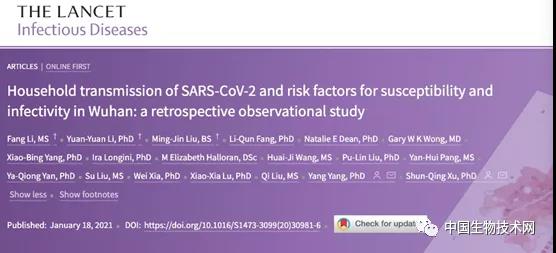Lancet: The spread of COVID-19 through children is stronger
- Normal Liver Cells Found to Promote Cancer Metastasis to the Liver
- Nearly 80% Complete Remission: Breakthrough in ADC Anti-Tumor Treatment
- Vaccination Against Common Diseases May Prevent Dementia!
- New Alzheimer’s Disease (AD) Diagnosis and Staging Criteria
- Breakthrough in Alzheimer’s Disease: New Nasal Spray Halts Cognitive Decline by Targeting Toxic Protein
- Can the Tap Water at the Paris Olympics be Drunk Directly?
Lancet: The spread of COVID-19 through children is stronger
Lancet: The spread of COVID-19 through children is stronger. Lancet: A study of more than 20,000 Wuhan Covid-19 families found that children are more capable of transmitting the virus, and it is recommended to be vaccinated.
On January 19, the internationally renowned journal Lancet “Lancet infectious disease” published online an epidemiological study on the intra-family transmission of the new coronavirus by the team of the School of Public Health of Huazhong University of Science and Technology.
The study focused on the characteristics of virus transmission in more than 20,000 Wuhan new coronavirus families, and found that infants and adolescents are less susceptible to the new coronavirus in the family than the elderly, but their transmission power is stronger.

In view of the above findings, the study recommends that when vaccine resources permit, because child cases have stronger transmission power, it is recommended that eligible children be vaccinated in time for the COVID-19 vaccine.
The study is a retrospective cohort study that included all confirmed cases of COVID-19 pneumonia (including laboratory confirmed cases and clinically confirmed cases) and asymptomatic infections reported in Wuhan from December 2, 2019 to April 18, 2020 Analysis of the person’s family. A total of 27101 families were included in the study, including 29578 cases of one generation and 57581 cases of close family contacts.
The study found that when the average incubation period of the new coronavirus is set to 5 days and the maximum infectious period is set to 22 days, the calculated second-generation incidence rate in the family is 15.6%.
The results of the study show that compared with people of other ages, people over 60 are at the highest risk of contracting the new coronavirus, while the susceptibility of babies aged 0-1 is higher than that of 2-5 years old (odds ratio (OR)=2.20) and 6-12 years old. Year-old children (OR=1.53). When the contact time is the same, the ability of children and adolescent cases (under 20) to infect others is 1.58 times that of people 60 and over.
At the same time, the study also found that the ability of asymptomatic infected persons to infect others is much lower than that of confirmed cases with clinical symptoms (OR=0.21), and that confirmed cases with symptoms have a stronger transmission power before the onset (incubation period) than after the onset ( OR=1.42).
After the implementation of strict epidemic intervention policies (such as isolation of cases and close contacts and restrictions on travel), the number of family reproductives (the number of people who can be infected by one case in each family) of a generation of cases has dropped by 52% (from 0.25 to 0.12) , The number of family reproductive cases in secondary cases decreased from 0.17 to 0.063, a decrease of 63%.
The findings of the study have important guiding significance for the formulation of control measures for the COVID-19 pneumonia epidemic. For example, when vaccine resources allow, due to the stronger transmission power of child cases, it is recommended that eligible children be vaccinated in time.
(source:internet, reference only)
Disclaimer of medicaltrend.org



